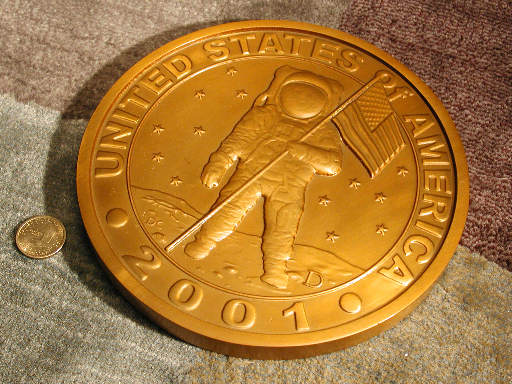slab this, PCGS !!!
 dcarr
Posts: 9,162 ✭✭✭✭✭
dcarr
Posts: 9,162 ✭✭✭✭✭
I made a really BIG coin.
Check out this cast-bronze piece compared to the Sacagawea dollar next to it:

Check out this cast-bronze piece compared to the Sacagawea dollar next to it:

0
Comments
<< <i>What does it weigh? >>
To Much
<< <i>What does it weigh? >>
About 10 pounds !
Very cool, uh, coin?
The Jolly Green Giant's pocket piece
Check out my current listings: https://ebay.com/sch/khunt/m.html?_ipg=200&_sop=12&_rdc=1
Worry is the interest you pay on a debt you may not owe.
"Paper money eventually returns to its intrinsic value---zero."----Voltaire
"Everything you say should be true, but not everything true should be said."----Voltaire
Here is how I make them:
First I sculpt the design in 3D (digitally) using a computer program
that I wrote. I actually sculpted this back in 1998 and kept the data
around. This is the first coin I ever designed.
Once the 3D surface is sculpted, I output a special file from my
software. This "G-Code" file contains all the instructions (3D
movement coordinates) for a computer-controlled milling/engraving
machine. I run the G-Code file on the machine and it moves the
cutting bit through the 3D coordinates from the file.
So what I actually cut on my machine is a 9" diameter 3D model of the
coin, cut as a "negative" (or mold) into black acrylic (Plexiglas).
The acrylic mold then serves two purposes:
1. I can pour wax into the mold, then take the wax to a local foundry
for "lost-wax" casting. I can make any number of them this way. But
there are some tricks to making it work - the wax likes to stick to the
acrylic if it isn't done right. So I make the wax, but the foundry
does the plaster shell and metal pouring. They also clean up the
casting flaws, such as small plaster cracks as well as the sprue
connections.
So they did the metal "chasing" and patina. I'm going to do the final
finishing and patina (if any) on all subsequent bronze pieces that I
make.
2. I can also send the same acrylic mold to a private mint and they
mount it on their reduction lathe to make dies using a
purely-mechanical transfer process. I've done that as well and I've
had some of these minted actual size (27mm diameter - see above).
Ask me no questions, I'll tell you no lies.
How do you capture the data from the object? Is it some type of scanner?
"ONE ROLLER" ??
Is that a way of avoiding COPY on the coin/medal or other legalities?
collections: Maryland related coins & exonumia, 7070 Type set, and Video Arcade Tokens.
The Low Budget Y2K Registry Set
Aerospace Structures Engineer
For newer board members who aren't aware, dcarr's designs were used on the New York, Rhode Island, and Maine state quarters.
New collectors, please educate yourself before spending money on coins; there are people who believe that using numismatic knowledge to rip the naïve is what this hobby is all about.
"Bongo hurtles along the rain soaked highway of life on underinflated bald retread tires."
~Wayne
<< <i>Very cool coin/medal. I like your other designs too.
"ONE ROLLER" ??
Is that a way of avoiding COPY on the coin/medal or other legalities? >>
Yes, it is close to "One Dollar", but I won't get in trouble for counterfeiting United States currency.
On my original digital sculpture, it said "One Dollar". That was done in 1998. When I went to have these minted recently, I had to change it - but I didn't have that same font on my new computer. So I just shuffled the existing sculpted letters around into "One Roller".
<< <i>That's cool. Please tell us more about the sculpt process.
How do you capture the data from the object? Is it some type of scanner? >>
The digital sculpting is performed using Virtual Sculptor ("VS3D"), a software program I wrote for this sort of purpose. Think of it as a tool for pushing digital clay around with your mouse.
VS3D home page
Looking for alot of crap.
design has the man on the moon for a year 2001 dated coin?
<< <i>nice work, your very talented. Just curious why your
design has the man on the moon for a year 2001 dated coin? >>
Thanks. Here is the answer from my web site:
In 1998 before Sacagawea was chosen as the theme for the new US Mint small "golden" dollar circulating coin, this Apollo Astronaut prototype designed by Daniel Carr was considered by the US Mint and Congress as a possible design. Renderings of it were featured in numerous publications including Coin World (front pages - March 30, 1998 and April 13, 1998 issues).
The obverse shows an Apollo Astronaut on the moon with a flag. At the time this coin was designed in 1998, nobody knew when the US Mint small "golden" dollars would first be issued. So the design was given a "2001" date, in honor of the movie "2001 A Space Odyssey".
...
<< <i>Wow, that gives my 1750 2-daler plate money some competition in the "monstercoin" category!
<< <i>
Now that is a cool item !
TorinoCobra71